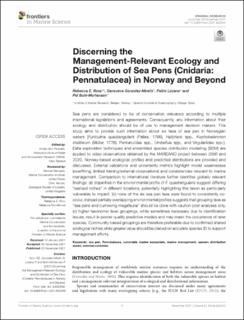| dc.description.abstract | Sea pens are considered to be of conservation relevance according to multiple international legislations and agreements. Consequently, any information about their ecology and distribution should be of use to management decision makers. This study aims to provide such information about six taxa of sea pen in Norwegian waters [Funiculina quadrangularis (Pallas, 1766), Halipteris spp., Kophobelemnon stelliferum (Müller, 1776), Pennatulidae spp., Umbellula spp., and Virgulariidae spp.]. Data exploration techniques and ensembled species distribution modelling (SDM) are applied to video observations obtained by the MAREANO project between 2006 and 2020. Norway-based ecological profiles and predicted distributions are provided and discussed. External validations and uncertainty metrics highlight model weaknesses (overfitting, limited training/external observations) and consistencies relevant to marine management. Comparison to international literature further identifies globally relevant findings: (a) disparities in the environmental profile of F. quadrangularis suggest differing “realised niches” in different locations, potentially highlighting this taxon as particularly vulnerable to impact, (b) none of the six sea pen taxa were found to consistently co-occur, instead partially overlapping environmental profiles suggests that grouping taxa as “sea pens and burrowing megafauna” should be done with caution post-analyses only, (c) higher taxonomic level groupings, while sometimes necessary due to identification issues, result in poorer quality predictive models and may mask the occurrence of rarer species. Community-based groupings are therefore preferable due to confirmed shared ecological niches while greater value should be placed on accurate species ID to support management efforts. | en_US |
